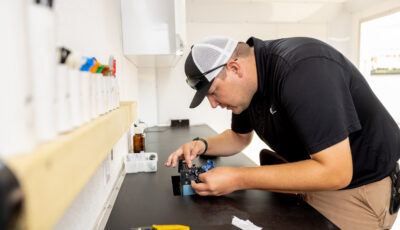You’ve got your Outdoor WiFi set up, and now you’re enjoying limitless connectivity—watching movies from your pool, doing office work on your patio or blasting your favorite playlist in your backyard workshop.
You should be good to go, right? Not so fast. While CLtel’s professional installation team will get you off to a good start with a weatherproof router that comes with speeds up to 1 Gig, there’s more to maintaining an Outdoor WiFi network than simply hitting “connect.”
Outdoor WiFi is like any other Internet connection—security is a must. You’ll need to take proactive steps to secure your network at every level and guard against intrusions. Here are our top tips for securing Outdoor WiFi networks.
Start With Physical Security
Before we get into cybersecurity, let’s begin with the obvious—keeping your physical router safe and secure. Protect your outdoor WiFi equipment from theft or tampering by securing it in weatherproof enclosures or mounting it in high, inaccessible locations. Cable locks and security cameras are great deterrents to theft and tampering.
Change Default Passwords
Routers come with factory-issued passwords to get you online quickly. But these passwords have a history of making their way onto hacker sites where they’re leaked for cybercriminals to exploit. Take the extra step of changing to a strong, unique password.
Enable Network Encryption
Encryption is a data-masking process that allows your information to stay safe and unusable even if it falls into the wrong hands. Think of it as the digital equivalent of putting on a disguise.
Add Guest Networks
Your home network is only as secure as the devices accessing it. Although your Great-Aunt Martha might not mean any harm, that suspicious link she clicks can open the floodgates for malware to infect your entire network. Guest networks close this loophole by isolating certain traffic from the main network you use for work, school or other high-priority tasks. Guest networks are also great for connecting your appliances. No need to worry about your smart refrigerator exposing the rest of your network.
Disable WPS
WiFi Protected Setup, or WPS, is a feature that allows users to connect to the Internet without going through difficult and time-consuming configurations. It is notoriously insecure, even with a strong password. Go into your router’s settings to ensure it’s turned off.
Implement Firewall Rules
A firewall monitors network traffic, deciding what, or who, can come and go. With this action, you’re free to specify which devices may access your network, effectively locking the gate to all others. Media access control address, or MAC address, filtering works similarly. Devices must be on an approved list to join your network.
Update Firmware Regularly
Many routers update automatically or allow you to switch to this setting. Still, it’s a good idea to check at least every few months to ensure the firmware your router runs on is up to date. Cybercriminals will try every entrance they can to get into your network to steal your data. Checking for firmware updates is the equivalent of making sure your back door is locked before you leave the house.
No network is entirely immune from attack. But with these tips, you’ll at least be doing the digital equivalent of locking all your doors and windows.



